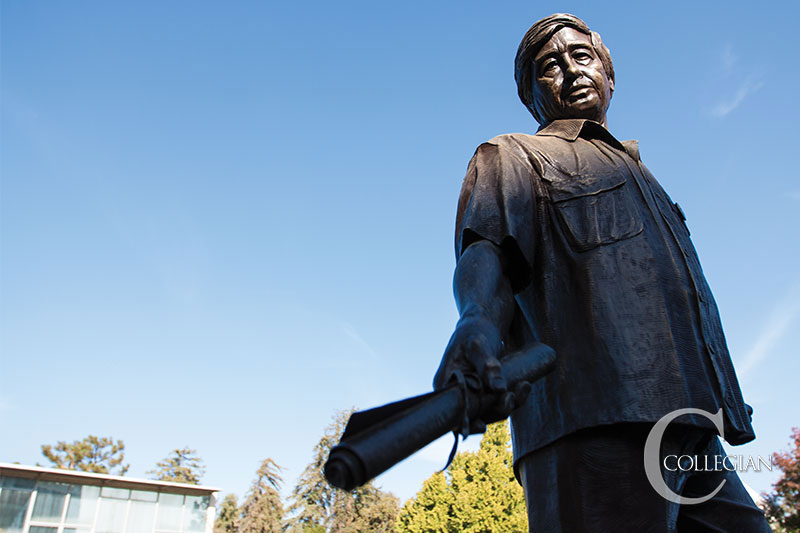
The National Park Service proposed Thursday to Congress to honor farm-labor leader Cesar Chavez with a historic park at four sites in California and another in Arizona.
In 2008, Congress directed the National Park Service to conduct a special resource study to identify sites significant to the farm-worker movement that met the historical landmark criteria, said Martha Crusius, Program Chief, Park Planning and Environmental Compliance at National Park Service.
Crusius was the project manager for what became known as the Cesar Chavez Special Resource Study. A list of more than 100 sites was pared down to five sites that meet the criteria: The Forty Acres National Historic Landmark in Delano; the Filipino Community Hall in Delano; McDonnell Hall in San Jose; Nuestra Señora Reina de la Paz, also known as La Paz in Keene, Calif.; and the Santa Rita Center, a downtown Phoenix church hall.
“The significance of the study was that Cesar’s works occurred in many different places,” said Marc Grossman, Chavez’s longtime spokesman, speech writer and personal aide. “There were dozens of locations across the country. The special resource study represents the breadth and legacy of his work. That’s why it is significant.”
Crusius said the park service partnered with CSU Fullerton to identify sites of meetings, demonstrations and marches in several states that were important to the farm-laborer movement.
“It was a major undertaking to look at the farm worker movement,” Crusius said. “One thing that was striking to us is that every community we visited said, ‘This story is important to us.’ People have a very personal connection. People would say, ‘I was involved in marches.’”
Fresno State professor emeritus Dr. Sudarshan Kapoor joined Chavez on many of those marches and demonstrations. But Kapoor wasn’t aware of Chavez or the movement for better pay and working conditions for farmworkers when he arrived as a professor at Fresno State in 1967.
Kapoor said what caught his attention and what he found inspiring about Chavez was his fast in 1968 against farmworkers resorting to violence.
“After that, he became a national hero,” Kapoor said. “He was fighting for human rights. I found out he was very much influenced by his own faith, which was Catholicism, but he had also studied Gandhi. During his fast he had Gandhi’s picture near his bed.”
Kapoor said he would often call Chavez the “Gandhi of the grapes.”
“He represented the plight and condition of the farm workers,” Kapoor said. “His movement is a testimony for the justice and for the human rights of the people who put the food on our tables.”
It wouldn’t be a typical national park, Crusius said, because of the disconnected sites. But there are other parks that are not geographically connected, too.
However, she said the sites are thematically connected.
On Oct. 8, 2012, President Barack Obama visited La Paz and declared it a national monument. La Paz encompasses about 187 acres but the federal government donated only 3 acres, which makes it the only area Obama was allowed to declare a national monument without Congress’ approval.
The site served as the national headquarters of the United Farm Workers (UFW) as well as the home and workplace of Cesar Chavez and his family from the early 1970s until Chavez’s death in 1993. The area includes his grave site, which will also be part of the monument.
The historic landmark in Delano is home to the union hall where grape growers signed their first union contracts. It was also where Chavez fasted in protest of pesticide use.
The Filipino Community Hall was a symbol of multiethnic unity in the 1960s where Filipino organizer Larry Itliong worked with Chavez. The hall in San Jose is considered where Chavez started his work as a community organizer.
The church was where it is believed the saying: “Si se puede,” or “Yes, we can,” originated during a meeting in 1972. UFW co-founder Dolores Huerta and Chavez, who was fasting, were in Arizona to resist a state law that restricted the rights of farmworkers to strike or boycott crops when Huerta uttered the famous slogan.
The far-reaching nature of the movement, Crusius said, added a degree of difficulty to the process and also the fact that for many people it was still living history.
“These sites deserve recognition and preservation,” Grossman said. “It [national park status] protects the property and helps preserve it to varying degrees for future generations.”





Willie Lopez • Dec 3, 2013 at 1:51 am
This is long overdue. Many years ago an effort was made to name a street in Fresno after him. The street signs were up for a day or two and then taken down. Then we tried to get the new high school in Sunnyside to be named after him, but that too was shot down. Maybe naming some national parks in his honor will get cities like Fresno where Cesar Chavez fought so hard for so many people to honor him properly.